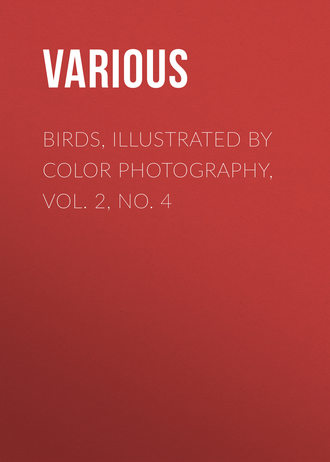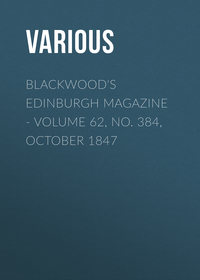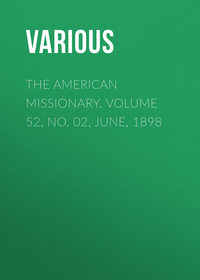 полная версия
полная версияBirds, Illustrated by Color Photography, Vol. 2, No. 4
THE WARBLING VIREO
THE Vireos are a family of singers and are more often heard than seen, but the Warbler has a much more musical voice, and of greater compass than any other member of the family. The song ripples like a brook, floating down from the leafiest tree-tops. It is not much to look at, being quite plainly dressed in contrast with the red-eyed cousin, the largest of the Vireos. In nesting time it prefers seclusion, though in the spring and mid-summer, when the little ones have flown, and nesting cares have ceased, it frequents the garden, singing in the elms and birches, and other tall trees. It rambles as well through the foliage of trees in open woodland, in parks, and in those along the banks of streams, where it diligently searches the under side of leaves and branches for insect life, “in that near-sighted way peculiar to the tribe.” It is a very stoic among birds, and seems never surprised at anything, “even at the loud report of a gun, with the shot rattling about it in the branches, and, if uninjured, it will stand for a moment unconcerned, or move along, peering on every side amongst the foliage, warbling its tender, liquid strains.”
The nest of this species is like that of the Red-eyed Vireo – a strong, durable, basket-like fabric, made of bark strips, lined with fine grasses. It is suspended by the brim in slender, horizontal forks of branches, at a great height from the ground.
The Vireo is especially numerous among the elms of Boston Common, where at almost any hour of the day, from early in the month of May, until long after summer has gone, may be heard the prolonged notes of the Warbling species, which was an especial favorite of Dr. Thomas M. Brewer, author of “History of North American Birds.” Its voice is not powerful, but its melody, it is said, is flute-like and tender, and its song is perhaps characterized more by its air of happy contentment, than by any other special quality. No writer on birds has grown enthusiastic on the subject, and Bradford Torrey alone among them does it scant justice, when he says this Vireo “is admirably named; there is no one of our birds that can more properly be said to warble. He keeps further from the ground than the others, and shows a strong preference for the elms of village streets, out of which his delicious music drops upon the ears of all passers underneath. How many of them hear it and thank the singer, is unhappily another question.”
THE SAPSUCKER
My Dear Young Friends:
During the long summer days, when you were enjoying golden vacation hours, I often took a peep at you from some dead tree limb or the side of a hemlock or beech. You saw me, perhaps, and were surprised at my courage; for other small birds whose voices you heard, but whose tiny bodies escaped your young eyes, appeared very timid in comparison.
But I am not so brave, after all, and know full well when my red hat is in danger. I am a good flyer, too, and can soon put a wide space between myself and certain wicked boys, who, I hope, by next vacation time will have learned so much about us that they will love every little feathered creature, and not seek to do them any harm.
Can you guess why I have such a queer name? I really ought to be popular in Illinois, for they tell me it is called the Sucker State, and that the people are proud of it. Well, I am called Sapsucker because much, if not most, of my food consists of the secret juices which flow through the entire body of the tree which you probably saw me running up and down and around. But you saw me, you say, very often on dead branches of trees, and surely they had no sap in them? No, but if you will look closely into my actions, you will see that I destroy many insects which drill their way into the wood and deposit their eggs. In my opinion, I do far more good than harm, though you will find some people who think otherwise.
Then, again, if there is utility in beauty, surely I am a benefit to every one. One day I heard a lady say that she never saw my head pop up from behind an old stump without bursting into laughter, I looked so funny. Now I took that as a compliment; for to give pleasure to those around us, I have heard, is one of our highest duties.
Next summer when you seek the pleasant places where I dwell, – in the old deadening where the trees wear girdles around them; in the open groves, where I flit from tree to tree; in the deep wooded districts, whence one hears the tinkling ripple of running waters, you may, if good and gentle, see pop up behind a stump the red hat of
Sapsucker.
THE WOOD PEWEE
The listening Dryads hushed the woods;The boughs were thick, and thin and fewThe golden ribbons fluttering through;Their sun-embroidered leafy hoodsThe lindens lifted to the blue;Only a little forest-brookThe farthest hem of silence shook;When in the hollow shades I heard —Was it a spirit or a bird?Or, strayed from Eden, desolate,Some Peri calling to her mate,Whom nevermore her mate would cheer?“Pe-ri! Pe-ri! Peer!”To trace it in its green retreatI sought among the boughs in vain;And followed still the wandering strainSo melancholy and so sweet,The dim-eyed violets yearned with pain.Long drawn and clear its closes were —As if the hand of Music throughThe sombre robe of Silence drewA thread of golden gossamer;So pure a flute the fairy blue.Like beggared princes of the wood,In silver rags the birches stood;The hemlocks, lordly counselors,Were dumb; the sturdy servitors,In beechen jackets patched and gray,Seemed waiting spellbound all the dayThat low, entrancing note to hear —“Pe-wee! Pe-wee! Peer!”“Dear bird,” I said, “what is thy name?”And thrice the mournful answer came,So faint and far, and yet so near,“Pe-wee! Pe-wee! Peer!”– J. T. Trowbridge.THE WOOD PEWEE
I am called the Wood Pewee, but I don’t always stay in the woods. If you have an orchard or a nice garden, you will hear me singing there in June.
People think I am not a happy bird, because my song seems so sad. They are very much mistaken. I am just as happy as any other little fellow dressed in feathers, and can flirt and flutter with the best of them.
Pewee! Pewee! Peer!
That is my song, and my mate thinks it is beautiful. She is never far away, and always comes at my call.
Always, did I say?
No; one day, when we were busy building our nest – which is very pretty, almost as dainty as that of our neighbor the Humming Bird – she flew away to quite a distance to find some soft lining-stuff on which to lay her eggs. I had been fetching and carrying all day the lichens to put round the nest, which was hidden among the thick leaves on the bough of a tree, and was resting by the side of it.
Pewee! Pewee! Peer!
“She will hear that,” thought I, and again I sang it as loud as I could.
“I’ll bring that fellow down, too,” said a boy, who surely had never heard anything about our happy, innocent lives, and as I peered down at him, he flung a large stone, which struck the bough on which I sat. Oh, how frightened I was, and how quickly I flew away!
“He has killed my little mate,” I thought. Still, I called in my plaintive way, Pewee! Pewee! Peer!
A faint, low cry led me to the foot of a large tree, and there on the ground lay my mate, struggling to rise and fly to me.
“I think my wing is broken,” she sobbed. “Oh, that wicked, wicked boy!”
I petted her with my broad, flat beak, and after a while she was able to fly with me to our nest; but it was days and days before she was out of pain. I am sure if that boy sees my story in Birds, he will never give such an innocent little creature misery again.
I dress plainly, in a coat of olive and brown, and they do say my manners are stiff and abrupt.
But my voice is very sweet, and there is something about it which makes people say: “Dear little bird, sad little bird! what may your name be?”
Then I answer:
Pewee! Pewee! Peer!
THE WOOD PEWEE
ALTHOUGH one of the most abundant species, common all over the United States, the retiring habits, plainness of dress, and quiet manners of this little bird have caused it to be comparatively little known. Dr. Brewer says that if noticed at all, it is generally confounded with the common Pewee, or Phoebe bird, though a little observation is sufficient to show how very distinct they are. The Wood Pewee will sit almost motionless for many minutes in an erect position, on some dead twig or other prominent perch, patiently watching for its insect prey. While its position is apparently so fixed, however, its eyes are constantly on the alert, and close watching will show that the bird now and then turns its head as its glance follows the course of some distant insect, while anon the feathers of the crown are raised, so as to form a sort of blunt pyramidal crest. This sentinel-like attitude of the Wood Pewee is in marked contrast to the restless motion of the Phoebe, who, even if perched, keeps its tail constantly in motion, while the bird itself seldom remains long in a fixed position. The notes of the two species (see August Birds) are as different as their habits, those of the Wood Pewee being peculiarly plaintive – a sort of wailing pe-e-e-e-i, wee, the first syllable emphasized and long drawn out, and the tone, a clear, plaintive, wiry whistle, strikingly different from the cheerful, emphatic notes of the true Pewee.
The Wood Pewee, like all of its family, is an expert catcher of insects, even the most minute, and has a remarkably quick perception of their near presence, even when the light of day has nearly gone and in the deep gloom of the thick woods. Dr. Brewer describes it as taking its station at the end of a low dead limb, from which it darts out in quest of insects, sometimes for a single individual, which it seizes with a sharp snap of its bill; and, frequently meeting insect after insect, it keeps up a constant snapping sound as it passes on, and finally returns to its post to resume its watch. While watching it occasionally twitters, with a quivering movement of the head and tail, uttering a feeble call-note, sounding like pee-e.
The nest of the Wood Pewee, which is always “saddled” and securely attached to a rather stout branch, usually lichen-covered, is said to be one of the most elegant examples of bird architecture. From beneath it so much resembles a natural portion of the limb, but for its betrayal by the owner, it would seldom be discovered. It is saucer-shaped, with thick walls, and the whole exterior is a beautiful “mosaic” of green, gray, and glaucous lichen. The eggs are a rich delicate cream color, ornamented by a “wreath” round the larger end of madder-brown, purple, and lilac spots.
The Wood Pewee has many admirers, a more interesting creature to watch while feeding being hard to imagine. Often you will find him in the parks. Sitting in some quiet, shady spot, if you wait, he will soon show himself as he darts from the fence post not far away, to return to it time after time with, possibly, the very insect that has been buzzing about your face and made you miserable. His movements are so quick that even the fly cannot elude him.
And to some he is pleasant as a companion. One who loves birds once saw this Flycatcher flying in a circle and repeating breathlessly his emphatic chebec. “He sang on the wing, and I have never heard notes which seemed more expressive of happiness.”
THE SNOWFLAKE
Bobbie didn’t want to go to school that morning, and he looked very cheerfully out upon the cloudy sky and falling flakes of snow, pretending to shiver a little when the angry gusts of wind blew the snow sharply into people’s faces.
“I guess it’s better for little boys like me to stay at home in such weather as this, mamma,” said he, all the while hoping the snow would soon be deep enough for him to ride down the hill on his sled.
Before his mamma could reply Bobbie gave a cry of delight which drew her at once to the window.
As from the snow clouds, on bold and rapid wing, came whirling down an immense flock of birds, white, streaked with gray and brown, chirping, calling to one another, the whole flock settling upon the open places in a field in front of Bobbie’s house.
“Oh, the dear little things,” said Bobbie, “they looked like little white angels dropping out of the clouds.”
“Those are our winter neighbors,” said his mamma, “the Snow Buntings or Snowflakes – they visit us only in winter, their summer homes being away up North near the Arctic Circle in the region of perpetual snow.”
“Do they build their nests in trees?” asked Bobbie, who never tired hearing about the birds.
“There are no trees in that bleak region, only scrubby bushes,” was the answer. “They build a thick, deep grassy nest, well lined with rabbit fur, or Snow Owl feathers, which they tuck under a ledge of rock or bunch of grass.”
“They chirrup just like sparrows,” reflected Bobbie, “can they sing?”
“They only sing when up in their Northern home. There a male Snowflake will sing as merrily as his cousin the Goldfinch.”
“They look like Sparrows, too,” said Bobbie, “only whiter and softer, I think.”
“In the summer they are nearly all white, the brown edges having worn away, leaving them pure black and white. They are very shy and suspicious, and at the least sound you will see them all whirl aloft braving the blasts of winter like little heroes.”
“Well,” said Bobbie, after a while, “if those little soft white birds can go about in such weather, I guess I can too,” and in a few minutes with high rubber boots, and a fur cap drawn over his ears, off trudged Bobbie like another little hero to school.
THE SNOWFLAKE
THIS charming bird comes to us at a time when his presence may be truly welcomed and appreciated, nearly all our summer companions of the feathered tribe having departed. He might not inappropriately be named the great Snowflake, though in winter he wears a warm brown cloak, with black stripes, brown collar, and a brown and white vest. In summer, however, he is snow white, with black on the back, wings, and tail. He lives all over northern North America, and in the United States as far south as Georgia.
About the first of November, flocks of Snowflakes may be seen arriving, the males chanting a very low and somewhat broken, but very pleasant song. Some call him White Snowbird, and Snow Bunting, according to locality. The birds breed throughout the Arctic regions of both continents, the National Museum at Washington possessing nests from the most northern points of Alaska, (Point Barrow), and from Labrador, as well as from various intermediate localities.
These birds are famous seed eaters, and are rarely found in trees. They should be looked for on the ground, in the air, for they are constantly seeking new feeding grounds, in the barn-yard, or about the hay stack, where seeds are plentiful. They also nest on the ground, building a deep, grassy nest, lined with rabbit fur or feathers, under a projecting ledge of rock or thick bunch of grass. It seems curious that few persons readily distinguish them from their sparrow cousins, as they have much more white about them than any other color. Last November multitudes of them invaded Washington Park, settling on the ground to feed, and flying up and scurrying away to successive pastures of promise. With their soft musical voices and gentle manners, they were a pleasing feature of the late Autumn landscape. “Chill November’s surly blast” making “field and forest bare,” had no terrors for them, but rather spread before them a feast of scattered seeds, winnowed by it from nature’s ripened abundance.
The Snowflakes disappear with the melting of their namesake, the snow. They are especially numerous in snowy seasons, when flocks of sometimes a thousand are seen in the old fields and meadows. It is unusual, though it has been known to breed in the Northern States. In July, 1831, Audubon found it nesting in the White Mountains, and Dr. J. A. Allen notes a pair as breeding near Springfield, Mass. The Arctic regions are its nesting place however, and these birds were probably belated on their return migration. The Snowflake and Shorelark are so much alike in habits, that the two species occasionally associate. Ernest E. Thompson says: “Apparently the Snowflakes get but little to eat, but in reality they always find enough to keep them in health and spirits, and are as fat as butter balls. In the mid-winter, in the far north, when the thermometer showed thirty degrees below zero, and the chill blizzard was blowing on the plains, I have seen this brave little bird gleefully chasing his fellows, and pouring out, as he flew, his sweet voluble song with as much spirit as ever Skylark has in the sunniest days of June.”
THE SLATE-COLORED JUNCO
BLACK SNOWBIRD, in most of the United States and in Ontario, where it is a common resident, and White Bill, are names more often applied to this species of Sparrow than the one of Junco, by which it is known to ornithologists. It nests in the mountains of northern Pennsylvania, New York, and New England, and is a resident throughout the year in northeastern Ohio, and in Michigan. In all probability, the Snowbird does not breed, even occasionally, anywhere within the limits of the state of Illinois, though individuals may in very rare instances be found several weeks after others have departed for the north, these having probably received some injury which prevents their migration. Prof. Forbes refers to such an instance, which came under his own observation. He saw on a tree in the edge of a wood, in the southern part of the state, an adult specimen of the Junco, and only one, which, he says, astonished him.
Mr. William L. Kells states that in Ontario this Junco selects a variety of places for nesting sites, such as the upturned roots of trees, crevices in banks, under the sides of logs and stumps, a cavity under broken sod, or in the shelter of grass or other vegetation. The nest is made of dry grasses, warmly and smoothly lined with hair. The bird generally begins to nest the first week of May, and nests with eggs are found as late as August. A nest of the Junco was found on the rafters of a barn in Connecticut.
Almost any time after the first of October, little excursion parties of Juncos may be looked for, and the custom continues all winter long. When you become acquainted with him, as you surely will, during his visit, you will like him more and more for his cheerful habits. He will come to your back door, and present his little food petition, very merrily indeed. He is very friendly with the Chick-a-dee, and they are often seen together about in the barn-yards, and he even ventures within the barn when seeds are frozen to the ground.
“The Doctor,” in Citizen Bird, tells this pretty story of his winter pets:
“My flock of Juncos were determined to brave all weathers. First they ate the seeds of all the weeds and tall grasses that reached above the snow, then they cleaned the honeysuckles of their watery black berries. When these were nearly gone, I began to feed them every day with crumbs, and they soon grew very tame. At Christmas an ice storm came, and after that the cold was bitter indeed. For two days I did not see my birds; but on the third day, in the afternoon, when I was feeding the hens in the barn-yard, a party of feeble, half-starved Juncos, hardly able to fly, settled down around me and began to pick at the chicken food. I knew at a glance that after a few hours more exposure all the poor little birds would be dead. So I shut up the hens and opened the door of the straw-barn very wide, scattered a quantity of meal and cracked corn in a line on the floor, and crept behind the door to watch. First one bird hopped in and tasted the food; he found it very good and evidently called his brothers, for in a minute they all went in and I closed the door upon them. And I slept better that night, because I knew that my birds were comfortable. The next afternoon they came back again. I kept them at night in this way for several weeks, and one afternoon several Snowflakes came in with them.”
THE KINGBIRD
IT is somewhat strange that there should be little unity of opinion concerning a bird as well known as is this charming fellow, who has at least one quality which we all admire – courage. We will quote a few of the opinions of well-known observers as to whether his other characteristics are admirable, and let the reader form his own conclusion.
John Burroughs says of him: “The exquisite of the family, and the braggart of the orchard, is the Kingbird, a bully that loves to strip the feathers off its more timid neighbors like the Bluebird, that feeds on the stingless bees of the hive, the drones, and earns the reputation of great boldness by teasing large hawks, while it gives a wide berth to the little ones.” Decidedly, this classifies him with the English Sparrow. But we will hear Dr. Brewer: “The name, Kingbird, is given it on the supposition that it is superior to all other birds in the reckless courage with which it will maintain an unequal warfare. My own observations lead me to the conclusion that writers have somewhat exaggerated the quarrelsome disposition of this bird. I have never, or very rarely, known it to molest or attack any other birds than those which its own instinct prompts it to drive away in self-defense, such as Hawks, Owls, Eagles, Crows, Jays, Cuckoos, and Grackles.” That Dr. Coues is a friend of the Kingbird, his language amply proves: “The Kingbird is not quarrelsome – simply very lively. He is the very picture of dash and daring in defending his home, and when he is teaching his youngsters how to fly. He is one of the best of neighbors, and a brave soldier. An officer of the guild of Sky Sweepers, also a Ground Gleaner and Tree Trapper killing robber-flies, ants, beetles, and rose-bugs. A good friend to horses and cattle, because he kills the terrible gadflies. Eats a little fruit, but chiefly wild varieties, and only now and then a bee.” If you now have any difficulty in making up your verdict, we will present the testimony of one other witness, who is, we think, an original observer, as well as a delightful writer, Bradford Torrey. He was in the country. “Almost, I could have believed myself in Eden,” he says. “But, alas, even the birds themselves were long since shut out of that garden of innocence, and as I started back toward the village a Crow went hurrying past me, with a Kingbird in hot pursuit. The latter was more fortunate than usual, or more plucky, actually alighting on the Crow’s back, and riding for some distance. I could not distinguish his motions – he was too far away for that – but I wished him joy of his victory, and grace to improve it to the full. For it is scandalous that a bird of the Crow’s cloth should be a thief; and so, although I reckon him among my friends – in truth, because I do so – I am always able to take it patiently when I see him chastised for his fault.”
The Kingbird is a common bird in Eastern United States, but is rare west of the Rocky Mountains. It is perhaps better known by the name of Beebird or Bee-martin. The nest is placed in an orchard or garden, or by the roadside, on a horizontal bough or in the fork at a moderate height; sometimes in the top of the tallest trees along streams. It is bulky, ragged, and loose, but well capped and brimmed, consisting of twigs, grasses, rootlets, bits of vegetable down, and wool firmly matted together, and lined with feathers, hair, etc.
THE KINGBIRD
You think, my young friends, because I am called Kingbird I should be large and fine looking.
Well, when you come to read about Kings in your history-book you will find that size has nothing to do with Kingliness. I have heard, indeed, that some of them were very puny little fellows, in mind as well as in body.
If it is courage that makes a king then I have the right to be called Kingbird. They say I have a reckless sort of courage, because I attack birds a great deal larger than myself.
I would not call it courage to attack anything smaller than myself, would you? A big man finds it easy to shoot a little bird in the air; and a big boy does not need to be brave to kill or cripple some poor little animal that crosses his path. He only needs to be a coward to do that!











